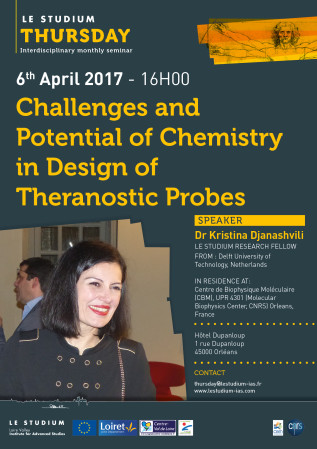Dr Kristina Djanashvili

Établissement d'origine
Delft University of Technology - NL
Laboratoire d'accueil
Centre de Biophysique Moléculaire (CBM) / CNRS - FR
Hôte scientifique
PROJET
Des Nanozéolites Intelligentes: Porosité et Confection sur Mesure de Surfaces pour l'Imagerie Multimodale et la Thérapie du Cancer
Le traitement contre le cancer exige son diagnostic précoce et des systèmes de délivrance de médicaments sans danger. À ce jour de nombreux traitements thérapeutiques ont échoué en raison de leur capacité limitée pour accéder au site malade de façon sélective sans endommager les cellules saines. En outre aucune des techniques d'imagerie existantes n’est absolument fiable en raison de leurs différences de résolution et de sensibilité. Ainsi la conception d’une sonde d’imagerie unique, visible dans différentes modalités est une stratégie prometteuse pour bénéficier, par exemple, du signal de TEP sensible et quantifiable et de la haute résolution de l'IRM. Les nanozéolites (NZ) sont parmi les candidats les plus prometteurs pour la réalisation de ce concept en raison de leur structure cristalline permettant de les charger en ions métalliques ayant des propriétés diagnostiques et thérapeutiques. Même si ces matériaux ont trouvé de nombreuses applications dans diverses technologies, leur utilisation médicinale n'a pas encore été pleinement explorée. Cet projet a pour objectif l'exploitation de NZ dont la structure aura été modifiée en vue des propriétés visées. Les fragments mésoporeux de la structure seront utilisés pour l'encapsulation de médicaments tandis que les petites cavités seront chargées avec des ions métalliques paramagnétiques et des traceurs d’imagerie nucléaire. L'efficacité in vivo des matériaux conçus s'appuiera sur la surexpression de molécules spécifiques (l'acide sialique, Sia) et d'enzymes dans les tumeurs par rapport aux régions saines. En effet les NZ seront modifiées spécifiquement à leur surface avec des fragments de conjugués phénylboronique et de l'acide poly-L-glutamique. Ceci permettra une reconnaissance de capables de Sia suivie par la coupure enzymatique des résidus de sucre par les protéases et la libération du médicament. En outre, l'hydrolyse enzymatique de l'adduit va ouvrir les pores donnant accès aux molécules d'eau à l'intérieur de la NZ et va donc augmenter la l’efficacité IRM, ainsi que déclencher la libération locale du médicament.
Publications in relation with the research project
Publications
Self-aggregating calix[4]arenes carrying four DOTA ligands on the upper rim for stable complexation of paramagnetic Gd III-ions have already been proposed as MRI probes. In this work, we investigate the luminescence properties of Tb III-DOTA-calix[4]arene-4OPr containing four propyl-groups and compare them with those of the analog substituted with a phthalimide chromophore (Tb III-DOTA-calix[4]arene-3OPr-OPhth). We show that, given its four aromatic rings, the calix[4]arene core acts as an effective sensitizer of Tb-centered luminescence. Substituents on the lower rim can modulate the aggregation behavior, which in turn determines the luminescence properties of the compounds. In solid state, the quantum yield of the phthalimide derivative is almost three times as high as that of the propyl-functionalized analog demonstrating a beneficial role of the chromophore on Tb-luminescence. In solution, however, the effect of the phthalimide group vanishes, which we attribute to the large distance between the chromophore and the lanthanide, situated on the opposite rims of the calix[4]arene. Both quantum yields and luminescence lifetimes show clear concentration dependence in solution, related to the strong impact of aggregation on the luminescence behavior. We also evidence the variability in the values of the critical micelle concentration depending on the experimental technique. Such luminescent calix[4]arene platforms accommodating stable lanthanide complexes can be considered valuable building blocks for the design of dual MR/optical imaging probes.
Surface PEGylation of nanoparticles designed for biomedical applications is a common and straightforward way to stabilize the materials for in vivo administration and to increase their circulation time. This strategy becomes less trivial when MRI active porous nanomaterials are concerned as their function relies on water/proton-exchange between the pores and bulk water. Here we present a comprehensive study on the effects of PEGylation on the relaxometric properties of nanozeolite LTL (dimensions of 20 × 40 nm) ion-exchanged with paramagnetic GdIII ions. We evidence that as long as the surface grafting density of the PEG chains does not exceed the “mushroom” regime (conjugation of up to 6.2 wt % of PEG), Gd-LTL retains a remarkable longitudinal relaxivity (38 s–1 mM–1 at 7 T and 25 °C) as well as the pH-dependence of the longitudinal and transverse relaxation times. At higher PEG content, the more compact PEG layer (brush regime) limits proton/water diffusion and exchange between the interior of LTL and the bulk, with detrimental consequences on relaxivity. Furthermore, PEGylation of Gd-LTL dramatically decreases the leakage of toxic GdIII ions in biological media and in the presence of competing anions, which together with minimal cytotoxicity renders these materials promising probes for MRI applications.
Final reports
Effective cancer treatment requires its early diagnosis in combination with safe drug delivery mechanisms. Up to date many therapeutics have failed due to their limited ability to reach the diseased site selectively without damaging healthy cells. Furthermore, none of the existing imaging techniques is absolutely reliable due to the differences in resolution and sensitivity. Therefore, synergistic combination of imaging modalities in one, typically nanodimensional, probe is the key-strategy to benefit from, for example the sensitive and quantifiable PET signal and the high resolution of MRI. Nanozeolites are among the most promising candidates for realization of this concept due to their unique crystalline structure capable of stable hosting of metal-ions with diagnostic and therapeutic properties. Even though, these materials have found many applications in various technologies, their medicinal potential still requires thorough investigations. This project aimed at the design, preparation and testing of novel nanozeolitic probes that can be applied as personalized drugs for diagnostic and therapeutic purposes


